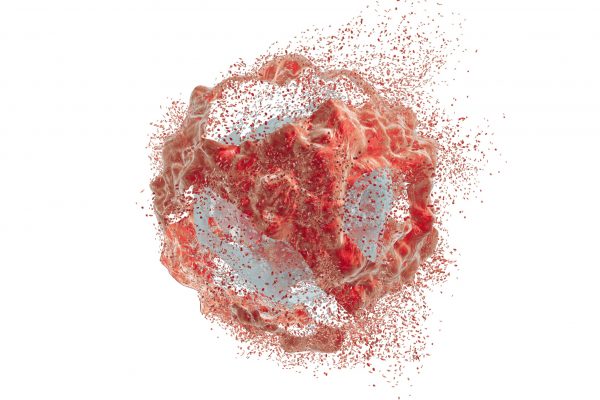
The randomised, phase III MURANO trial has previously established the superior progression free survival (PFS) of venetoclax-rituximab compared to bendamustine-rituximab at 48 months follow-up in chronic lymphocytic leukaemia (CLL) patients. This ongoing, open-label, multicentre trial compares venetoclax-rituximab (VenR) (Ven 400mg daily for 2 years, standard dose R for the first 6 months) to bendamustine-rituximab (B 70mg/m2, standard dose R for the first 6 months) in 389 patients with (r/r CLL). Updated, 5-year efficacy outcomes, with a focus on long-term minimal residual disease (MRD) kinetics, as well as a sub-study, in which participants with subsequent disease progression (PD) were given a VenR regimen, are due to be presented at the ASH 2020 meeting.
At a median follow-up of 59.2 months, the median PFS of VenR, compared to BR, was sustained, with a median PFS of 53.6 months and 17.0 months, respectively. This corresponds to a 81% reduction in the risk of progression (HR[95%CI]: 0.19[0.15-0.26]). 130 patients completed the full 2-year Ven regimen, in which, the estimated PFS 3-years post-end of treatment (EOT) was 51.1%. The previously observed overall survival (OS) benefit of VenR was maintained, compared to BR, with 5-year OS estimates of 82.1% and 62.2%, respectively, resulting in a 60% reduction in the risk of mortality (HR[95%CI]: 0.40[0.26-0.62]).
Interestingly, improved OS outcomes were observed in patients who received VenR that reached EOT without PD, who had undetectable MRD (uMRD), compared to those with MRD, with 3-year post-EOT OS estimates of 95.3% and 85.0%, respectively. Furthermore, 32 patients who had uMRD at EOT had not shown PD and remained uMRD at 5 years. A further 47 patients had MRD conversion at 5 years, with a median time to MRD conversion from EOT of 19.4 months, and 4 patients had PD without prior MRD conversion. Of the 47 patients who had confirmed MRD conversion, 19 subsequently developed PD, with a median time to PD from MRD conversion of 25.2 months. Of note was the fact that these 19 patients displayed a more rapid increase in rate of MRD post-EOT compared to patients that had MRD conversion but did not exhibit PD.
Unmutated immunoglobulin
The baseline presence of del(17p), GC and unmutated immunoglobulin heavy chain gene (IGVH) were associated with an increased risk of MRD conversion and subsequent PD post-EOT, in patients who were uMRD at EOT. All 4 patients with del(17p) experienced MRD conversion with subsequent PD. Forty-four percent of patients with GC experienced MRD conversion with PD, compared to 20% of patients without GC. A further 37% of patients with unmutated IGVH also experienced MRD conversion with PD, compared to 4% of patients without. Conversely, patients without del(17p), GC or unmutated IGVH were more likely to maintain uMRD, or experience MRD conversion without PD, once uMRD had been achieved at EOT.
No new safety signals were observed at this 5-year update. Excluding non-melanoma skin cancers, 2 second primary malignancies were reported, since the previous update, in patients receiving VenR (Acute myeloid leukaemia and multiple myeloma). Rates of Richter transformation remain balanced between both treatment arms (7 on VenR, 6 on BR). 29 patients were subsequently enrolled into the sub-study, following PD, with biologic profile data, response rates and MRD in response to re-treatment, to be presented at the ASH 2020 meeting.
Conclusion
Five-year follow-up data from the MURANO trial demonstrates a sustained PFS and OS benefit in r/r CLL patients who received VenR, compared to BR, with no new safety concerns. Within the VenR cohort, uMRD at EOT is associated with improved OS. Furthermore, patients who did not present with del(17p), GC, or who had mutated IGVH were associated with lower rates of MRD conversion with subsequent PD, after establishing uMRD at EOT. Overall, a substantial proportion of patients who completed VenR treatment maintained uMRD status at 36 months post-treatment, displaying a durable response following a 2-year, fixed-duration VenR regimen.
Reference
Kater, A P et al., Five-Year Analysis of MURANO Study Demonstrates Enduring Undetectable Minimal Residual Disease (uMRD) in a subset of Relapsed/Refractory Chronic Lymphocytic Leukemia (R/R CLL) Patients (Pts) Following Fixed-Duration Venetoclax-Rituximab (VenR) Therapy (Tx). Presented at ASH 2020. Abstract 125, session 642.